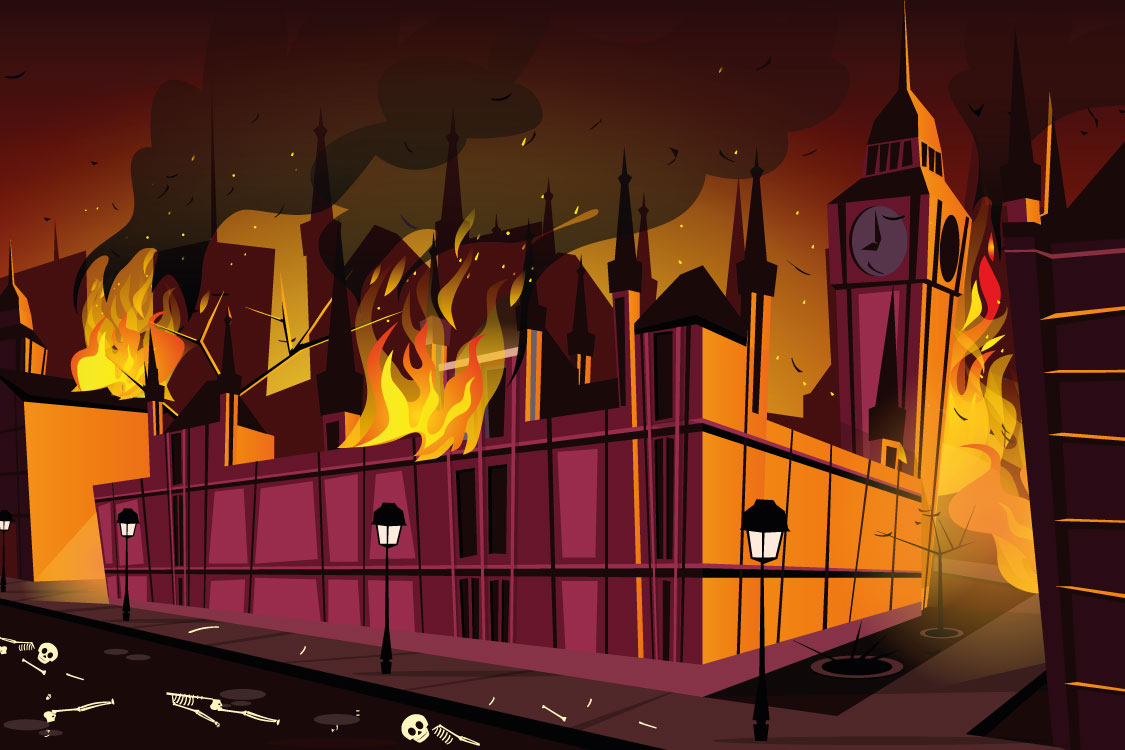The Great Fire of London
The Great Fire of London started on the night of Sunday 2 September 1666, and although the worst was over by Wednesday, it was not until the following Sunday that rain eventually doused the final flames.
The fire started at a baker’s shop run by one Thomas Farriner on Pudding Lane – the road is still there, just to the north east of London Bridge – and spread quickly, mainly towards the river to the south and St Paul’s Cathedral to the west.
Attempts to fight the blaze were not helped by the fact that much of the city was exceptionally dry after a hot summer, there was a strong wind from the east to fan the flames, and that people abandoning their homes blocked the narrow streets, preventing those making what firefighting efforts there were from getting around the city to where they were needed.
Very few lives were lost directly in the fire – some estimates place it as less than ten, although more would have died subsequently from the effects of smoke inhalation, disease and homelessness.
It is estimated, however, that as many as 13,200 houses (representing the homes of approximately 70,000 of the city’s 80,000 residents), together with 87 parish churches, The Royal Exchange, Guildhall and St Paul’s Cathedral were destroyed in the blaze.

There’s no smoke without fire
The story goes that the fire had started earlier in the evening, but Thomas Farriner thought he’d put it out, and so he and his family went upstairs to bed.
By 1a.m. on Sunday morning, however, the building was well on fire and the family had to escape via an upstairs window to the house next door. One of those few to lose their lives in the actual fire was the Farriners’ maidservant, who was too scared to attempt the perilous escape.
A simple smoke detector such as we now take for granted today, and which is a mandatory fixture in modern rented accommodation, would have alerted Thomas Farriner to the fact that his attempts to put out the fire had been unsuccessful and would almost certainly have saved not only his business and home, but those of his friends, neighbours and many thousands more besides. Not to mention the life of the poor maidservant.
Prevention is always better than cure
Not to put too fine a point on it, London in 1666 was a disaster waiting to happen and the only surprise is that a disaster on such a scale hadn’t already happened.
Houses were made out of wood covered with flammable pitch, and topped off with thatched roofs which jutted out over the narrow roads, so that flames could pass from one to the next with ease. Meanwhile, stores and warehouses along the riverfront were packed with all kinds of combustible material.
A modern fire risk assessment would have looked at London and made multiple recommendations for alterations to the way houses were constructed in order to minimise the opportunities for fires to both start and spread.
Every cloud has a silver lining
Good can come out of even the worst disasters – the lessons we learn from them can help stop similar things happening again. Before 1666, fires were tackled in what can best be described as a haphazard fashion. The main tactic was to create a firebreak by demolishing buildings in its path, but on this occasion it is believed that delays attributed to the Lord Mayor prevented that being done.
After the Great Fire, businessmen started to offer insurance against the dangers of fire. To protect their investment, they employed men to tackle fires as soon as they broke out. And so were created the first fire brigades.
Providing the means to respond quickly should a fire break out is a key component of a modern fire emergency plan.
A fire such as that which occurred in September 1666 shouldn’t be able to happen today. As we’ve seen, modern fire detection methods, fire alarms systems, building planning regulations and effective means of control would have prevented much of the disaster that resulted from one moment of carelessness.
But we should never take things for granted – that’s why there are strict guidelines in place which ensure that all business premises and rented accommodation have to carry out fire risk assessments, install suitable smoke detectors and fire alarm systems, and make available suitable fire extinguishers to tackle any fire that does break out.
To find out how you can make your home or business premises as fire-safe as possible or our services such as fire alarm systems, risk assessments and fire stopping, simply contact the team at Scutum London today.
Request a Callback
Just fill in your details below and we'll get back to you as soon as we can!

About Scutum London
Scutum London is a leading expert in fire safety and security solutions for businesses and organisations located across South East England, including London and Surrey.
From fire alarms, fire extinguishers and fire risk assessments to access control, CCTV and intruder alarm systems – and a lot more besides – we offer a comprehensive range of products and services designed to keep you, your business and your staff and visitors safe.
With decades of industry experience to call on, we’re proud to hold accreditations from leading trade associations and bodies such as British Approvals for Fire Equipment (BAFE), the British Fire Consortium, the Fire Industry Association (FIA) and Security Systems and Alarms Inspection Board (SSAIB).
If you’d like to find out more about Scutum London, get in touch with our friendly team or explore our products and services on our site.

